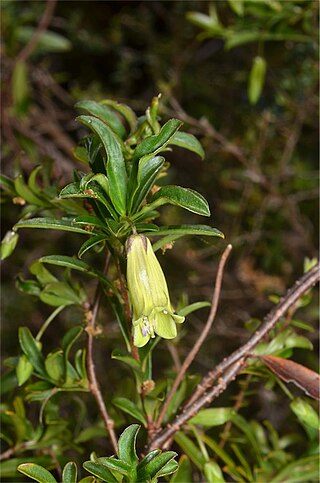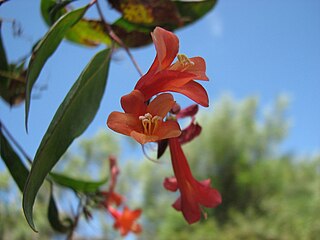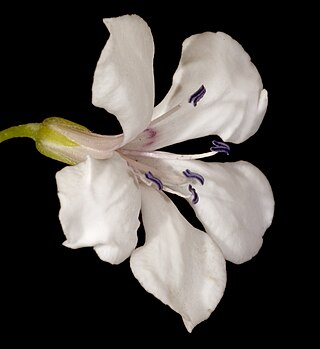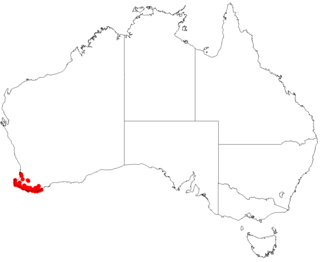
Billardiera longiflora is a species of flowering plant in the family Pittosporaceae and is endemic to Tasmania. It is a woody twiner or climber that has variably-shaped, often elliptic leaves, often varying with altitude, and greenish-yellow, pendent, tube-shaped flowers arranged singly and turning blue as they age. This species is often confused with the similar Billardiera macrantha of south-eastern Australia, including Tasmania.

Marianthus is a genus of flowering plants in the family Pittosporaceae and is endemic to Australia. Plants in the genus Marianthus are shrubs with twining branches, simple leaves arranged alternately along the stems. The flowers are pendent, arranged singly or in small groups in upper leaf axils or on the ends of branches with small bracts and bracteoles at the base, but that fall as the flowers open. The sepals are free from each other, and the petals are also sometimes free from each, otherwise joined at the base, forming a tube with spreading lobes. Plants in this genus were previously included in Billardiera, but have a stalked ovary and a long, usually curved style. The fruit is a dehiscent capsule containing many seeds.

Billardiera sericophora is a species of flowering plant in the family Pittosporaceae and is endemic to the south-east of South Australia. It is spreading shrub or climber that has mostly narrowly elliptic leaves and pendent yellow flowers arranged singly or in pairs.

Billardiera fraseri, commonly known as elegant pronaya, is a species of flowering plant in the family Pittosporaceae and is endemic to the south-west of Western Australia. It is a climber with densely silky-hairy new shoots, leaves and flowers, narrowly elliptic leaves and deep purple or pink flowers arranged in groups.

Billardiera fusiformis, commonly known as Australian bluebell, is a species of flowering plant in the family Pittosporaceae and is endemic to the south-west of Western Australia. It is a sturdy, shrubby climber that has linear to narrowly elliptic leaves and blue, white or pink, nodding flowers arranged singly or in groups of up to four.

Marianthus candidus, commonly known as white marianthus, is a species of flowering plant in the family Pittosporaceae and is endemic to the south-west of Western Australia. It is a twining shrub or climber with elliptic leaves and white flowers arranged in groups of twenty to thirty and becoming fawn or pink as they age.

Marianthus tenuis is a species of flowering plant in the family Pittosporaceae and is endemic to the southwest of Western Australia. It is a slender, twining shrub with clustered, narrowly elliptic leaves and white flowers tinged with mauve and with darker spots on three of the five petals.

Marianthus drummondianus is a species of flowering plant in the family Pittosporaceae and is endemic to the southwest of Western Australia. It is a shrub, herb, or slender twiner with elliptic leaves and white, blue or purple flowers arranged in small clusters.

Billardiera floribunda, commonly known as white-flowered billardiera, is a species of flowering plant in the family Pittosporaceae and is endemic to the south-west of Western Australia. It is a robust twining shrub or climber that has thick, leathery, elliptic leaves and white or pinkish flowers arranged in groups of ten or more.

Billardiera laxiflora is a species of flowering plant in the family Pittosporaceae and is endemic to the far south-west of Western Australia. It is a delicate, twining shrub or climber that has linear leaves and white flowers tinged or spotted with pink or mauve.
Marianthus aquilonaris is a species of flowering plant in the family Pittosporaceae and is endemic to a restricted part of the southwest of Western Australia. It is an erect, multi-stemmed shrub with elliptic to oblong leaves and pale blue to almost white flowers arranged singly in leaf axils.

Billardiera mutabilis, commonly known as climbing apple berry, apple berry, snot berry, apple dumplings or changeable-flowered billardiera, is a species of flowering plant in the family Pittosporaceae and is endemic to south-eastern Australia. It is a slender climber or twiner with narrowly elliptic leaves and bell-shaped, greenish-yellow flowers that turn bluish as they age.

Marianthus bignoniaceus, commonly known as orange bell-creeper, is a species of flowering plant in the family Pittosporaceae and is endemic to Victoria. It is a slender climber with egg-shaped or narrowly egg-shaped leaves and green and orange or salmon-pink flowers arranged singly or in pairs.
Marianthus coeruleopunctatus, commonly known as blue-spotted marianthus, is a species of flowering plant in the family Pittosporaceae and is endemic to the southwest of Western Australia. It is a twining shrub or climber with narrowly elliptic leaves and pale blue flowers sometimes with dark blue spots or lines, arranged in branched clusters.

Billardiera ovalis is a species of flowering plant in the family Pittosporaceae and is endemic to Tasmania. It is a woody, creeping scrambler with thick, egg-shaped or elliptic leaves, and creamy-yellow flowers arranged singly in leaf axils, but turning red as they age.
Marianthus dryandra is a species of flowering plant in the family Pittosporaceae and is endemic to a restricted area in the southwest of Western Australia. It is an erect, straggling shrub with densely hairy new shoots, stem-clasping, egg-shaped leaves and cream-coloured flowers with maroon spots, arranged on short side shoots.
Marianthus granulatus is a species of flowering plant in the family Pittosporaceae and is endemic to a restricted part of the southwest of Western Australia. It is a twining shrub or climber with often clustered, egg-shaped to heart-shaped leaves and pale blue flowers with darker blue spots and yellow streaks, arranged in groups of three to five.
Marianthus microphyllus is a species of flowering plant in the family Pittosporaceae and is endemic to the south of Western Australia. It is a small, erect, spreading shrub with clustered, funnel-shaped, stem-clasping leaves and deep blue to almost purple flowers that darken as they age, arranged singly in leaf axils.

Marianthus ringens is a species of flowering plant in the family Pittosporaceae and is endemic to the southwest of Western Australia. It is a shrub or climber with thick, elliptic leaves and yellow and orange-red flowers that darken as they age, arranged dense clusters.

Billardiera variifolia is a species of flowering plant in the family Pittosporaceae and is endemic to the southwest of Western Australia. It is a twining shrub or climber with elliptic adult leaves and groups of deep purple flowers that fade to blue as they age.
















